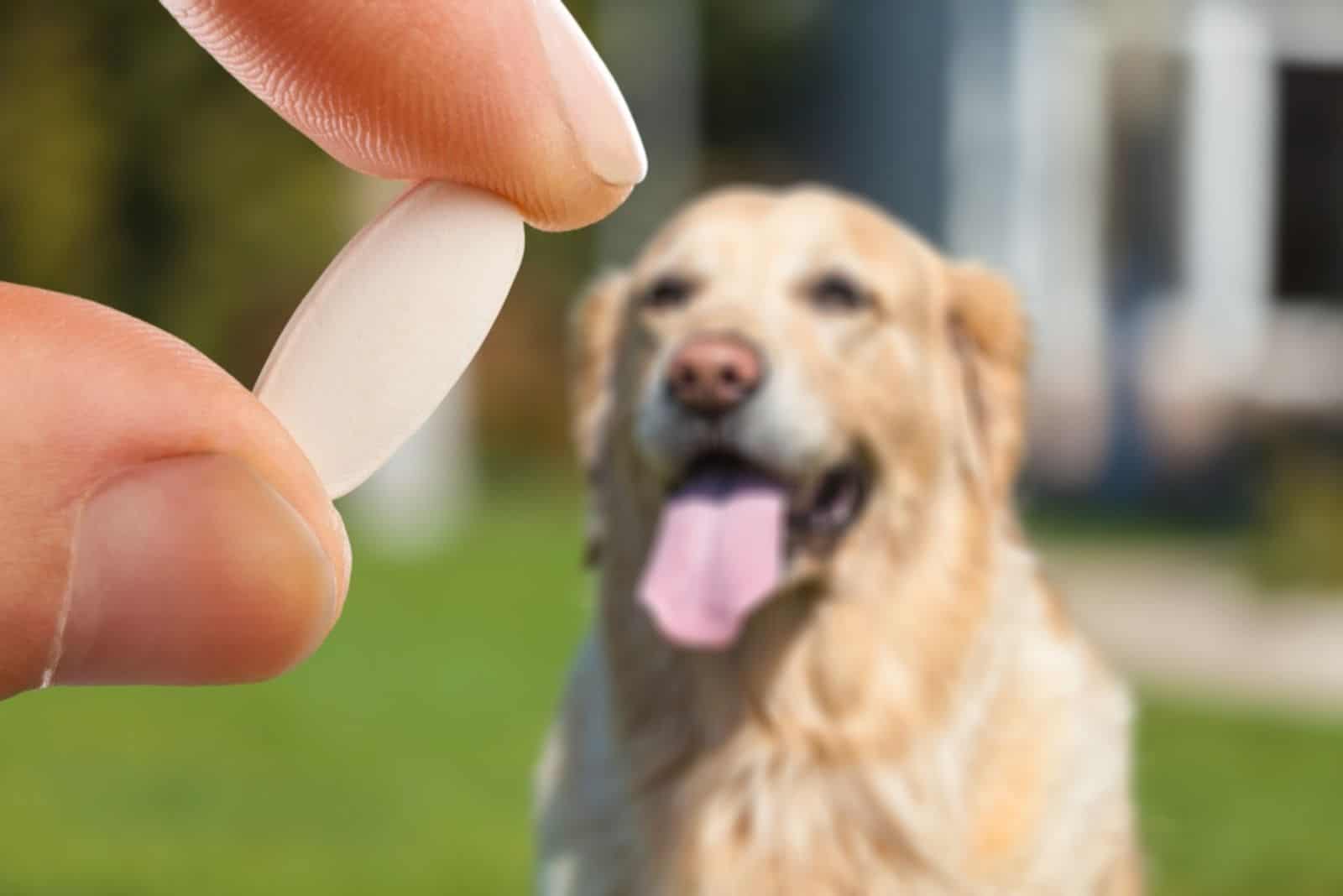Dogs do not have the ability to tell us if something is wrong. This is why it is important to carefully read their body language and inspect every physical change on their bodies. Some body changes are more obvious while others are not.
Whatever the change might be, we know that it is scary and that dog owners go into panic mode, and that is completely normal. One of the changes that a dog’s body can develop is red paws.
Red paws on dogs are not a nice sight to see and you can tell that the dog is most likely uncomfortable by that.
We are here to help you out by listing all the possible reasons for your dog’s paws turning red. It is always good to know these things even if the best solution is to take your dog to the vet.
By knowing some of the causes you can help your vet figure out what is the real reason for the redness. Some causes you probably won’t be able to figure out because you need a lot more knowledge as a vet does.
Now that we got that covered, we can start with the causes of red paws on dogs.
What Causes Red Paws On Dogs?
Before we start with the causes, we need to talk a bit about the redness itself. It is called erythema. This is the more medical term for this condition. This redness can be located in two places on the paws:
– Paw Pads: When it comes to redness on paw pads it will be a lot clearer and easier to notice on dogs that have lighter paw pads. When the redness is severe you will also be able to see it on paw pads that are a darker color. The red pigmentation will be harder to notice on darker pads if it is not that severe.
– Skin: This can be hard to notice as well if the dog has long hair. Even with dogs that have shorter hair, the mild red color will not be that obvious. The red patches can cause the hair in those places to fall off and that is when it gets really easy to notice. Redness is best detected on the dog’s armpit area, between their toes, and groins.
There is this term that is often used when it comes to red paws, and that is Pododermatitis. This is something that is usually listed as a cause of red paws because it is considered to be an infection.
Pododermatitis always has an underlying cause and because of this, we do not want to list it as a cause. We can say that this is a cause with a cause. When the vet tells you that your dog has Pododermatitis it will not make a lot of things clearer.
You still need to find out what caused it.
Read More: My Dogs Paws Are Pink: Is That Normal Or A Cause For Worry?
Now that we have located the redness it is time to figure out what out of the things from the list is the reason for it. Here are possible reasons for your dog’s red paws.
Note before starting, we wanted to make things clearer so we put some causes within a category so you can know what is what. For example, you will be able to see that within infections and allergies that there are a couple of common things connected to both.
We did not want to separate all the causes because it can get confusing.
1. Infections
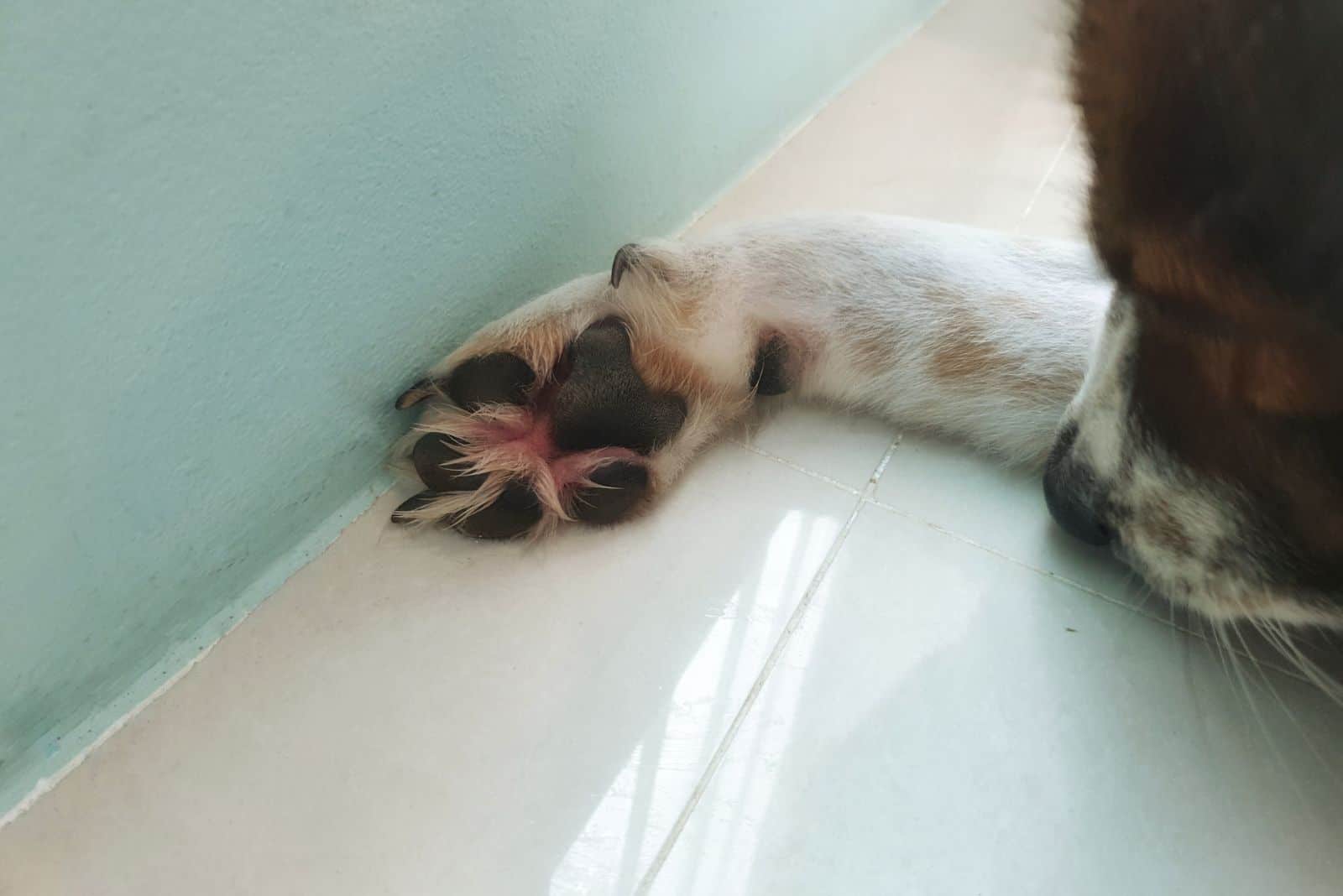
The causes of infection are pathogenic organisms. Two of the main pathogenic organisms that cause skin infections are fungi and bacteria. When a skin infection occurs, the main symptom is the redness of the paws.
There are two common types of skin infections, and they are:
– Dermatophytosis: Microsporum and Trichophyton are the two fungi that cause this type of fungal infection. This is usually noticed on the skin of the paw and can sometimes be accompanied by alopecia.
– Superficial pyoderma: This infection is caused by a bacterium, and to be more precise Staphylococcus intermedius is the bacteria that causes it. When dogs have this bacterial infection, you will see them being really uncomfortable and trying to itch their paws. You will need to help them soothe the itchiness.
– Yeast Infection: This type of infection appears when there is Candida on the skin and a lot of it. It can be located on the paws, genitals, and skin folds. It causes redness and itchiness.
2. Allergies
Allergies are considered to be the most common reason for your dog’s red paws. The foot pads or the skin around them will become really itchy and because of that your dog might be licking them and even biting them to ease the itchiness.
This can cause even more redness which will prolongate the healing period. Try to protect your dog’s feet and make the itching a bit more bearable.
Here are the most common allergies that can cause red paws in dogs.
– Contact Dermatitis: This happens when a dog’s skin comes in touch with something that they are allergic to. The main things that are in this category are different types of chemicals and grass. When it comes to chemicals the most common ones are cleaning remedies that we use around the house. If you notice that your dog’s paws are all of a sudden getting red, make sure that you did not buy any new cleaning remedies. The redness will appear and there will probably be some hair falling off in those areas.
– Food Allergy: This means that your dog is allergic to a certain nutrient in its food. This can be harder to detect especially when they are older, and you have been giving them pretty much the same food for a long time. The redness will not only appear on the paws but on the rest of the body as well. Hair loss might be possible as well.
RELATED: Can Dogs Eat Jalapenos? The Effects Of Spicy Foods On Dogs
– Flea Bite Allergy: This is caused by the saliva of the flea that is transmitted to the skin as they bite the area. This does not mean that every dog that has fleas will get this reaction, only the ones that are hypersensitive. You may be able to notice some skin scrapes as well, and Alopecia.
– Atopic Dermatitis: Environmental allergens are the ones to blame for this type of allergy. The most common allergens are dust mites and pollen. French Bulldogs are really prone to this type of dermatitis.
Allergic reactions might not be the most dangerous cause of red paws, but if it goes unnoticed they can cause some other health issues that can get severe and scary. In most of these cases, you will be able to notice your dog licking its paws to soothe the itchiness.
Paw licking can be worsening the condition because the dog’s saliva and the texture of the tongue can cause even more redness. It might soothe the itching for a moment but make the inflamed skin even more inflamed.
RELATED: Dog Losing Hair Around Eyes: Causes Of Canine Alopecia
3. Parasitic Diseases
These types of diseases when you connect them with red paws are mostly caused by mites. Two of those diseases are:
– Sarcoptic Mange: This is caused by a mite called Sarcoptes scabiei. This does not only occur on the paws but on the face, ears, and bony parts of the dog’s body. You will be able to notice paw peeling, scabs, alopecia, and thickening of the skin.
– Demodicosis: This is caused by a mite known as red mange and to be more professional the medical term for this mite is Demodex canis. The symptoms are almost the same as with the Sarcoptic Mange.
4. Cuts And Blisters
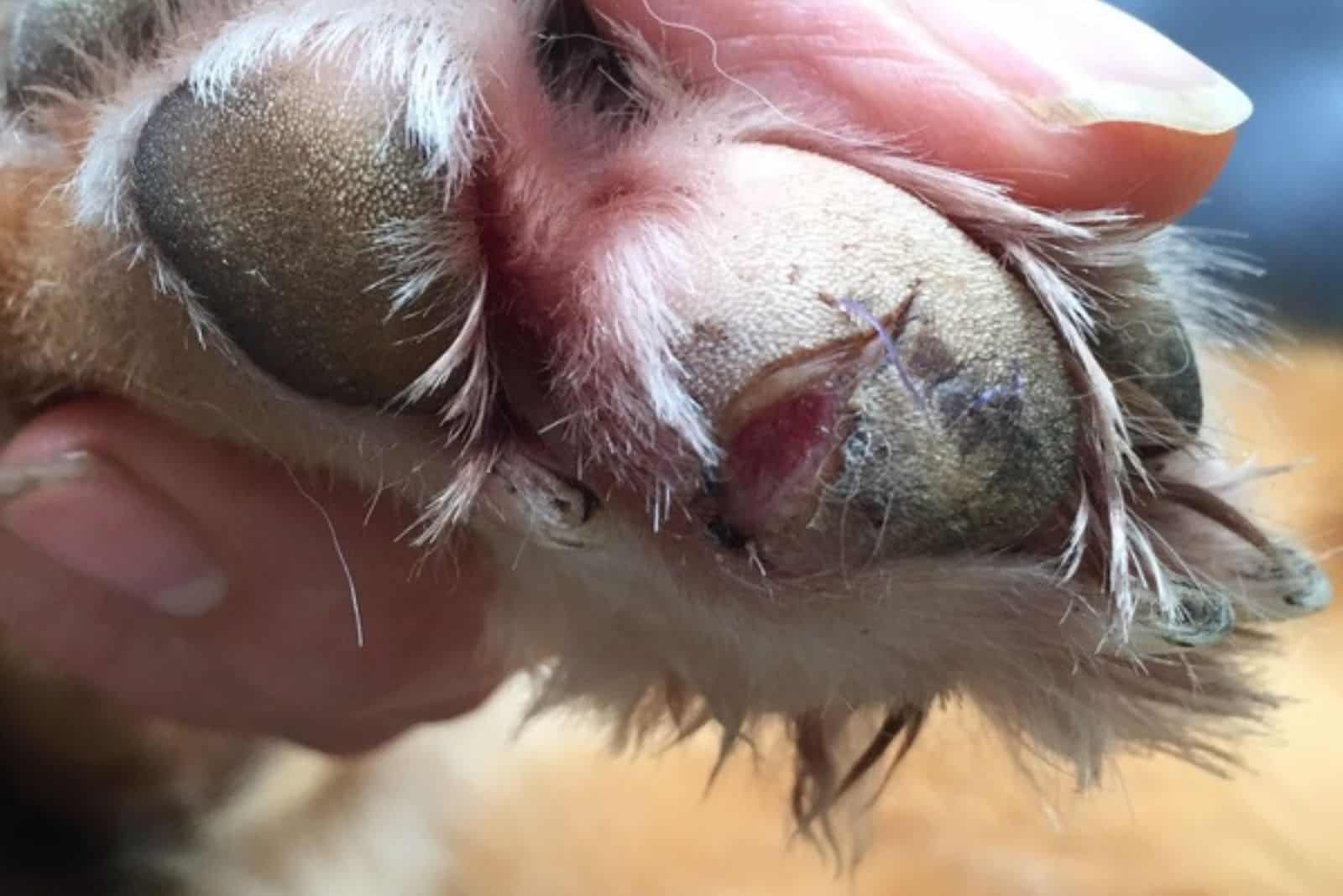
The skin on the dog’s paw pads is really strong and can handle almost anything, but every now and then something can be on the floor that causes your dog to get a cut.
This is common with dogs that spend a lot of time in nature where there are many sharp things that can cause the dog to get a cut.
Blisters and cuts cause redness and even pain in the dog’s paws. Blisters can be easier to notice than cuts. The size and depth of the cut can make it easier or harder to notice. With dogs that get a smaller cut and have dark paws, it can be hard to notice the redness.
The whole paw won’t become red, just the part where the blister and the cut are.
Dog’s skin on the paw is more susceptible to getting cut, especially with dogs that have short coats.
5. Extreme Temperatures
If you live in places that get extremely cold or extremely hot, you need to know that dog paws can get injured. A hot pavement is one of the most common causes of red paws in dogs. It can cause your dog a lot of pain so you will probably be able to notice limping.
Frostbite is also common if you live in a place that has extremely cold temperatures. In both cases, you need to find the best option to protect your dog’s paws.
You can always ask your vet for some advice.
6. Ringworms
Even though the name has the word worm in it, these pests are not worms. In fact, they are fungi. When your dog has ringworm, you will be able to notice red patches that are often scaly and red. Hair loss will most likely be noticeable.
This can be hard to notice at first with dogs that have dark paw pads. But the thing with ringworms is that they usually don’t stay only in one place.
They can spread to every part of the body. In the beginning stages, dogs that have long coats will not showcase the redness, but you will be able to see them itching. When the hair starts falling out then you will be able to see the red patches.
7. Biting And Licking
Some dogs have the habit of biting on their paws. This is mostly their playful and curious side, and sometimes when they are bored, they will start chasing their tail and biting on their paws.
The biting or gnawing is not severe, and they do not cause pain to themselves, but it can cause some redness that can further develop into something more serious.
Excessive licking is usually a showcase that something is already wrong and that they are trying to ease whatever is bothering them. If a dog, for example, has a small cut and starts licking its paws excessively, it can only make the cut bigger, redder, and even inflamed.
RELATED: Why Does My Dog Lick Me? 9 Reasons For This Behavior
8. Foreign Bodies In The Paw
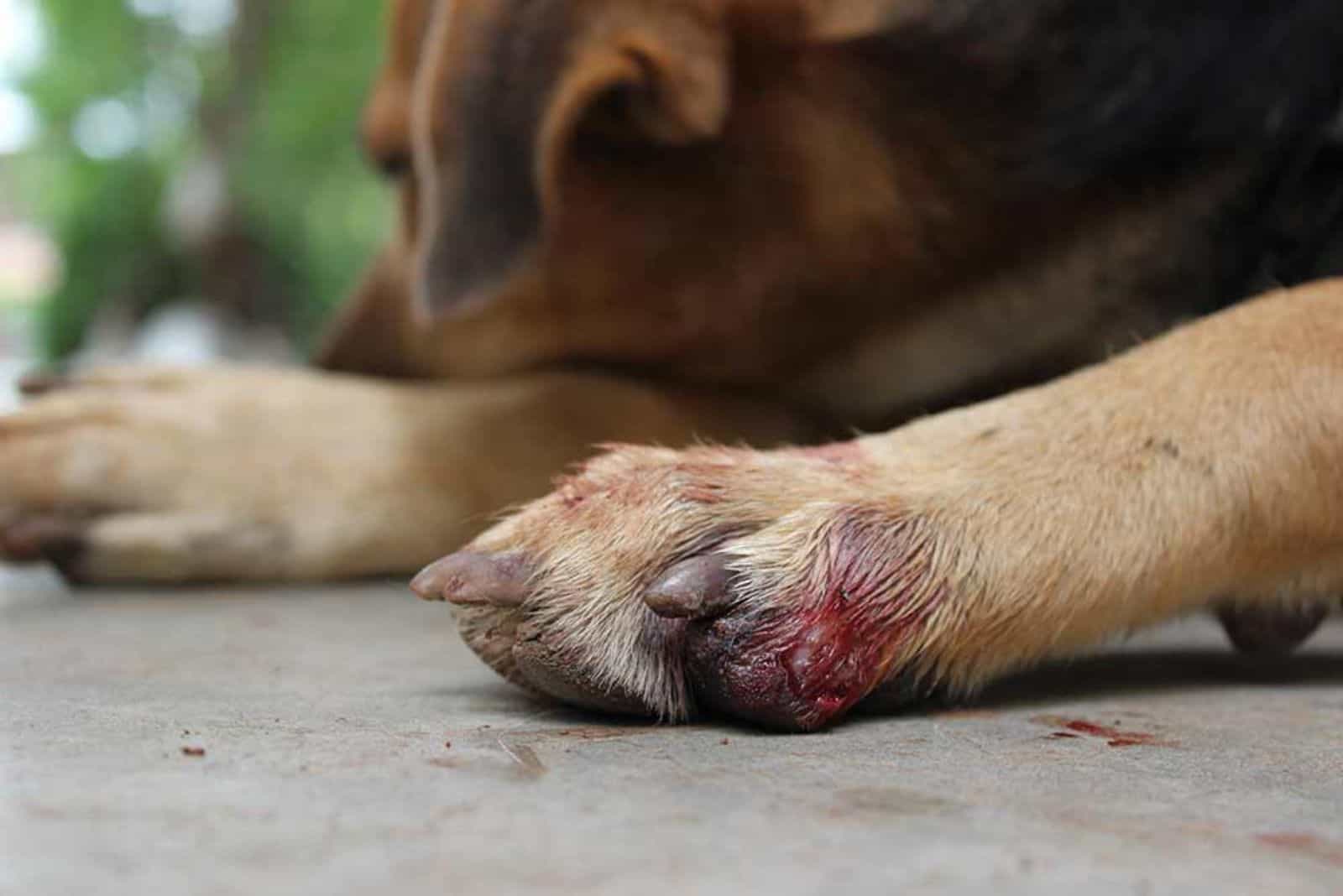
This is also one of the common causes of red paws in dogs. If a foreign object gets stuck in the paw it can cause a lot of pain, irritation, and redness.
Sharp objects can not only cut the dog, but they can also get stuck in the paw pad or skin on the paw. Some of these sharp objects are glass, sticks, nails, etc. If you spend a lot of time in nature you might not be able to clearly see sharp objects.
This is why you should check your dog’s paws every time you come home.
Foreign bodies in your dog’s paw will make the dog slowly reject it because it will detect that this thing is not supposed to be there. Because of this a secondary infection, mostly bacterial, can occur.
One of the things that is really tricky and can easily get stuck in the paw is foxtail. They are grass clusters that are really pointy. Why are these tricky?
Well since they are pointy, they are really difficult to get out of the paw. The points face in the other direction so when you try to take it out, it can get even more stuck and will cause your dog a lot of pain.
If they get too deep, they usually need to get out on their own. They will travel to some other place in the paw area and will make a small hole to get out. In this process, the dog will form some type of scab and will probably lick it which will cause the scab to be even more painful and red.
This can get dangerous because foxtails can travel further than the paw area. If you see that you cannot take out the foxtail by yourself, contact the DVM.
They might need to make a small incision in the place they feel the foxtail is located.
9. Canine Cognitive Dysfunction (CCD)
CCD is considered to be doggy dementia. We mentioned that licking the paw when there is already some issue can cause that issue to get even worse.
But when dogs have this condition, they are not licking their paws because they are trying to soothe something that is bothering them. They are licking their paws simply because they like the feeling.
When a dog has this disorder you can expect anxiety, night walking, and forgetfulness as well.
10. Ingrown Toenail
You probably thought that ingrown toenail is something that only we people can experience. Well, you are wrong. Dogs can have ingrown toenails as well.
This can happen if you do not clip your dog’s nails regularly and they get too long. When this happens, the nail starts to curl in the direction of the paw bed.
Nail poking the paw bed will cause your dog to be in pain and discomfort. The place where the nail is poking will become red.
The dog will have difficulty walking. The ˝good thing˝ about this problem is that it is easily noticeable.
11. Symmetrical Lupoid Onychodystrophy (SLO)
This might seem like an ingrown toenail but it is not. This is a condition where the claws are brittle, break really easily, and do not grow properly.
This affects all of the dog’s toes, but some can be worse than others. If your dog has injured or broken a certain nail several times, they will most likely have a lot of problems with that nail when it comes to this condition.
12. Anxiety

Anxiety is something that can affect not just people, but dogs as well. We tend to forget that because they do not showcase anxiety as we do. The closest thing that we can showcase when being anxious is for us biting our nails and for dogs is licking their paws.
The paw licking may soothe the dog and make it a bit more at ease. The front paws are usually the ones that will be affected more because it is easier for the dog to lick them.
Your dog will probably choose one of the front paws, rarely both. Because of the excessive licking, the paw will get red.
Besides licking their paws, dogs that have anxiety will pace around, become more clingy or needy, and will stop eating.
RELATED: Why Is My Dog Acting Weird All Of A Sudden: 17 Odd Dog Behaviors
13. Abrasive Ground
If you wondered, ‘why are my dog’s paws red all of a sudden?’ This might be the answer. Cement, sand, and asphalt are some of the abrasive grounds that can cause your dog’s paws to become irritated and red.
When it comes to beach sand you can protect the paws and it won’t be a big problem, especially if you do not go to the beach often.
When it comes to asphalt it can be a bit tricky. If your dog has extremely sensitive paws you will need to protect them every time you go out. If your dog has problems from time to time because of asphalt, try to take care of the paws by putting on certain ointments like a cream that your vet prescribes.
14. Alabama Rot
Alabama Rot is a deadly disease that is commonly found in the UK. It is especially spread in winter and autumn when there is a lot of mud on the ground.
If you live in the UK and notice that your dog has red paws or red scabs on the paws, contact the vet immediately. It might not be this disease, but better be safe than sorry that is for sure.
15. Tumors And Cysts
Every growth on the body, including the paw, can cause inflammation and redness. If malign or benign tumors appear they will look like a swelling and they will appear red.
An interdigital cyst is something that is not that unusual to find on a dog paw, or in other words, is a growth that can affect the dog’s paw in particular and it can appear from various causes.
The part where the cyst appears will be red, and between the paw beds is the place where it is most likely to appear. The dog will most likely lick that part severely.
When it comes to treatment it depends on the underlying cause.
16. Ticks

Ticks can get hooked on any part of the dog’s body, and this includes the paws as well. When the tick sticks to the dog its saliva can cause some irritation which will appear red.
A tick can be hard to detect sometimes and when they are located on the paw it can be even impossible to see them. But the good thing is that you will see your dog nibble on its paw and that will give you a reason to examine the paw in more detail.
You can remove the tick by yourself, but if you do not feel comfortable you can call the vet. It would be a good idea to take your dog to the vet even when you take the tick out by yourself just to make sure that it did not succeed in getting your dog sick.
Keep the tick in a bag so you can take it to the vet. When the vet looks at the tick, he or she can determine for how long it was stuck on your dog’s paw.
RELATED: What To Do If You Find A Dried Dead Tick On Dog
17. Hookworms
These pests can be quite annoying and even dangerous for your dog. They usually affect the paw of a dog causing them to become red and itchy.
This is not that common of an occurrence, but it can affect dogs that are kept in groups and on concrete.
18. Insect Bites
When it comes to insect bites is that there will always be some bump left behind and it will usually be red. But the main problem is that you can not determine what bug bit your dog unless you saw it with your own eyes when the bite occurred.
Some of the insects are harmless and can only cause a bit of irritation to the dog’s skin. On the other hand, there are some insects that are potentially poisonous or can cause your dog to have an allergic reaction.
What Are The Symptoms That Are Associated With Red Paws On Dogs?
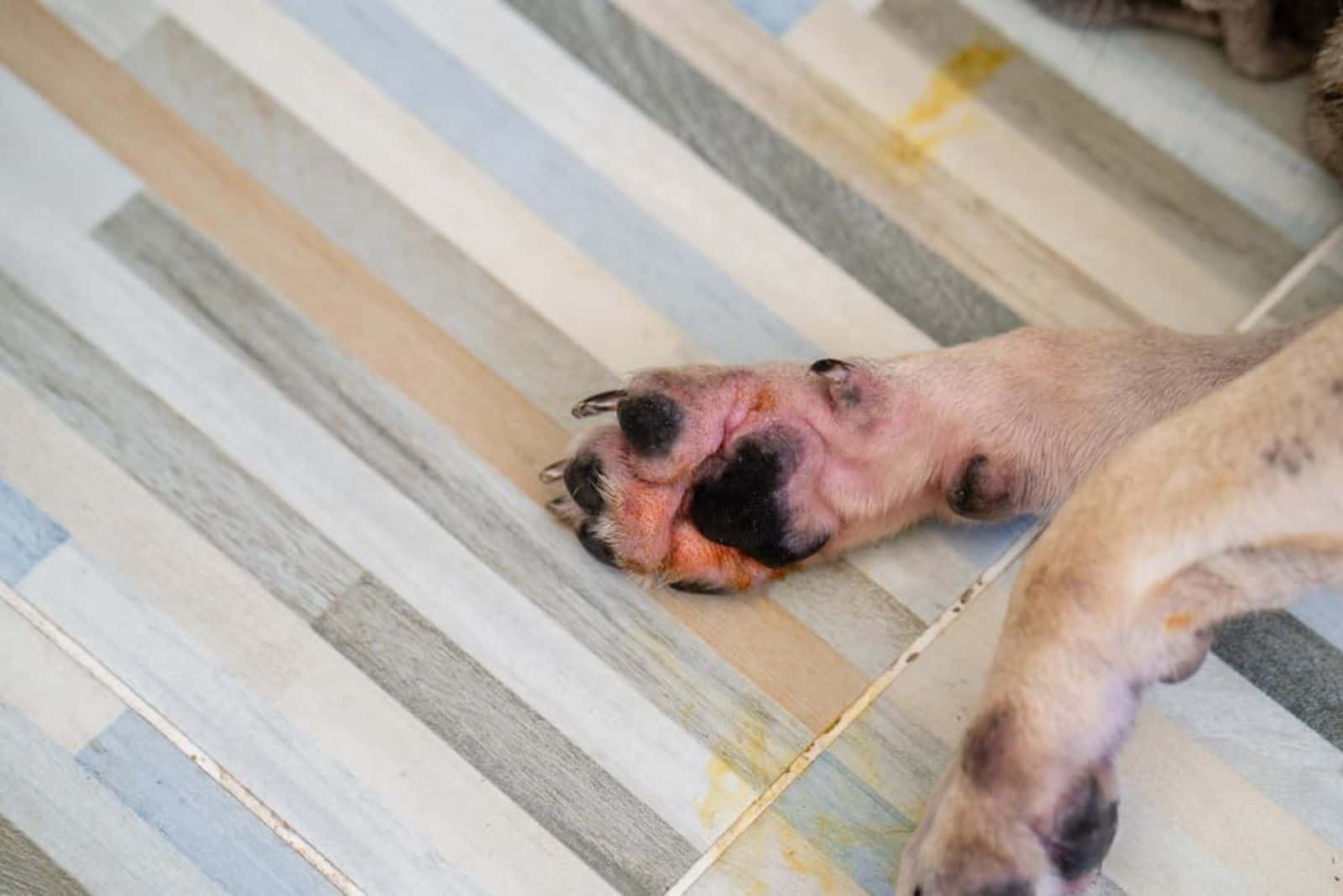
We already saw that erythema or redness can be caused by various things, but is redness the only thing that can appear on the paws of your dog?
Here are some of the symptoms that can occur besides redness.
– Flaking or dandruff
– Alopecia-hair loss
– Pustules (accumulation of pus)
– Papules (small reddish pimples)
– Scabs
– Itching
– Erosions and ulcers
– Abscesses
– Lesions
– Burrs
Some of these symptoms can help the vet to determine what the underlying cause of the redness is. Sometimes the dog’s immune system can get compromised which causes dog health to deteriorate.
RELATED: What’s With That Tick Scab On Dog? Tick Removal 101
Home Remedies For Treating Red Paws On Dogs
When it comes to home remedies you need to know that they are not a replacement for any medication that the vet has prescribed for your dog. But they can be extremely helpful in solving the issue and making your dog comfortable.
You can also combine the two. Here are some of the treatment options you can give to your dog if their paws are red:
– Antiparasitic drugs. You will give this to your dog if it has problems with parasites which you can combine with antiparasitic shampoo.
– Antiseptics. You will use this when your dog gets cut by a sharp object. You will disinfect the cut and put a bandage to make sure that the cut is secure and won’t get affected.
– Antifungals Or Antibiotics. This is used when your dog has an infection. What will you use out of these two depends on what type of infection the dog has. You can use sodium hypochlorite solutions (dilution 1/10).
– Immunotherapy drugs. You will use this if your dog is having an allergic reaction. What drug specifically will be used depends on the type of allergy.
– Warm Water. This clearly is not any type of medication. If you soak your dog’s paws in warm water, you will help ease the itchiness and even pain a bit. You can also use medicated shampoos to help those irritated paws.
How To Prevent Red Paws On Dogs?
It is extremely important to make sure that the paws of your dog are in good condition. There are some things that you can do so the paws will not get irritated and red, but there are some things that are out of our control.
Things can happen even if you are doing your best every day to prevent them from happening, so do not feel guilty if your dog gets red paws.
Here are some of the things that you can do to try and prevent your dog’s paws from getting red.
– Do a frequent paw check. This is the main thing you need to do. Checking paws should be something you do on a daily basis, especially after a walk when you come home. This way you will know what your dog’s paws look like and will be able to notice quickly if your dog has a cut or a tick on its paw.
– Try to avoid taking your dog for a long walk during harsh weather conditions. Extreme hotness or even cold can cause your dog to have major issues with their paws. It can be painful and extremely uncomfortable for them. You can always use booties for your pooch when the weather conditions are not in your favor.
– Being up to date with tick and flea medication. This way you will avoid any parasites that want to get attached to your dog. If you are not consistent with giving your dog this medication, it will not be protected from these types of parasites.
– Trim your dog’s nails often. This way your dog will not get ingrown nails. Dogs that spend a lot of time on asphalt will not need their nails trimmed that often, but dogs that don’t will need it. If you do not feel comfortable doing it yourself, you can take them to the vet or a professional groomer.
– Treat their allergies before any symptoms occur. If you ever find out that your dog has allergies, you will probably be given some medication or supplements that you can give to your dog to ease the symptoms.
– Try avoiding environmental allergies. This means that you should try to avoid using a lot of cleaning chemicals around your dog. If you decide to clean your house thoroughly, try doing it when your dog is out for a walk.
– Carefully pick the place where you will be walking your dog. Every dog owner has a route that they like to take when going for a walk with their dog. You can probably take that route with your eyes closed, but the thing is, you always need to have one eye on the ground to make sure that your dog will not step on anything sharp.
– Wash the paws thoroughly. When you are washing the paws try to do it in detail. Always wash and dry the part between the toes carefully.
To Sum It All Up
Any change on your dog’s body needs to be taken seriously. One of those changes is the redness of the paws. There are a lot of causes that can lead to red paws on dogs, like yeast dermatitis, allergies, ticks, sharp objects, cuts, etc.
Some are out of our control no matter how hard we try, while other causes can be prevented. The list of the potential causes of red paws is always good to know.
Whatever the reason might be, you need to take your dog to the vet to be sure that everything is fine.
We hope that the list of causes and the list of things that you can do to prevent this from happening have helped you. We also hope that your doggie’s red paws are not an indication of anything serious and that he or she will recover soon.
CONTENT YOU WILL LIKE:
– Why Is My Dog’s Nose Dry? How To Tell If Your Dog Is Sick
– Dog Coughs After Drinking Water: Here Are 6 Reasons Why
– 12 Explanations Why Do Dogs Noses Turn Pink
– 7 Signs Your Dog With Diabetes Is Dying












